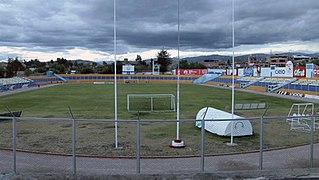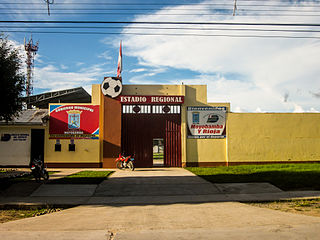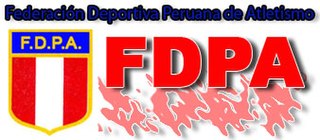 W
WEstadio 25 de Noviembre is a multi-purpose stadium in Moquegua, Peru. It is currently used by football team San Simón de Moquegua. The stadium holds 21,000 people and was built in 2009. This will be one of the six venues in five cities for the 2019 FIFA U-17 World Cup.
 W
WThe Copa Bicentenario is a football competition in Peru played by the football clubs of the Liga 1 and Liga 2. It was founded in 2019 and was played as a domestic football cup competition between clubs of the first and second division.
 W
WThe Estadio Campeones del 36 is a multi-use stadium in Sullana, Peru. It is used by the football team Alianza Atlético. The stadium holds 12,000 people and was built in 2000. It is a small stadium which was expanded.
 W
WEstadio Campeonísimo is a multi-use stadium in Piura, Peru. It is currently used by football team Atlético Torino. The stadium holds 8,000 people. The stadium also holds Copa Peru matches for some of the local teams in Talara.
 W
WEstadio Ciudad de Cumaná is a multi-purpose stadium in Ayacucho, Huamanga, Peru. It is currently used mostly for football matches and is the home stadium of Ayacucho FC of the Peruvian Primera División and Deportivo Municipal de Huamanga of the Copa Perú league. The stadium holds 12,000 spectators. It was built to commemorate the 150th anniversary of the Battle of Ayacucho by the government of Venezuela under the leadership of Carlos Andrés Pérez. It is named after the city of Cumaná which is the birthplace of Antonio José de Sucre who was the commander of the United Liberation Army during the Battle of Ayacucho. It is part of the larger Complejo Deportivo Venezuela or Venezuela Sports Complex which includes other sporting facilities built by the Venezuelan government.
 W
WEstadio Daniel Alcides Carrión is a multi-use stadium located in Cerro de Pasco, Peru. It is used by football team Unión Minas. The stadium holds 8,000 people and is the highest stadium in the world, with an altitude of 4,380 meters (13,973 ft) above sea level. This makes it very difficult for players who are not used to playing at this height and has caused some controversy.
 W
WEstadio Enrique Torres Belón is a multi-purpose stadium in Puno, Peru. It is currently used by football team Alfonso Ugarte. The stadium is built out of stone and has a capacity of 20,000 people. It is named after Senator Enrique Torres Belón from the Puno Region. The stadium is also the site of the Fiesta de la Candelaria every February.
 W
WEstadio Heraclio Tapia is a multi-purpose stadium in Huánuco, Peru. It is used by football team León de Huánuco. The stadium holds 25,000 people.
 W
WEstadio Héroes de San Ramón is a multi-use stadium in Cajamarca, Peru. It is currently used by football team Club Universidad Técnica de Cajamarca. The stadium seats 18,000 people. The origin of its name comes from the battle of San Pablo, where three students from San Ramón de Cajamarca School died for Perú, in the War of the Pacific. This stadium is undergoing improvements by the Peruvian Institute for Sport.
 W
WEstadio Huancayo is a multi-use stadium in Huancayo, Peru. It is currently used mostly for football matches and is the home of Sport Huancayo and Deportivo Junín. Other teams that previously used the stadium are Deportivo Wanka and Meteor Junin. The stadium holds 20,000 people.
 W
WEstadio IPD de Moyobamba is a multi-use stadium in Moyobamba, Peru. It is currently used mostly for football matches and is the home stadium of Unión Comercio of the Peruvian Primera División. The stadium holds 8,000 spectators. Renovations are expected to start on the stadium which would expand it to hold 20,000 spectators.
 W
WEstadio Juan Maldonado Gamarra is a multi-use stadium in Cutervo Province, Peru. It is currently used mostly for football matches and is the home stadium of Comerciantes Unidos and Los Inseparables de Cutervo of the Copa Perú. The stadium holds 8,000 spectators.
 W
WEstadio Julio Lores Colán is a multi-use stadium in Huaral, Peru. It is currently used by football team Unión Huaral. The stadium holds 10,000 people. The stadium is named for Julio Lores Colán, born in 1908, who was a Peruvian-Mexican football forward who played for Peru in the 1930 FIFA World Cup.
 W
WEstadio Manuel Gómez Arellano was a multi-use stadium in Chimbote. It is no longer used by football team José Gálvez FBC. The stadium held 15,000 people. It was replaced by Estadio Olímpico Municipal in 2007.
 W
WThe Estadio Max Augustín is a multi-purpose stadium in Iquitos, Peru. It is the home ground of the football (soccer) team Colegio Nacional Iquitos and several other Copa Perú teams from Iquitos and the surrounding region. The stadium holds 24,576 people. It was built in 1942 and renovated in 2005. The stadium has artificial turf, an artificial running track, and was a venue in the 2005 FIFA U-17 World Championship
 W
WEstadio Miguel Grau is a multi-use stadium in the Bellavista District of Callao, Peru. The stadium is part of the Sport Village of Callao or Yahuar Huaca, which is owned by the Callao Regional Government since 2011. Its use is available to several football teams in the region including Sport Boys, Universidad de San Martín and Academia Cantolao who play their home matches here for the Torneo Descentralizado. The stadium's maximum capacity is 17,000 and was inaugurated on 16 June 1996 with a match between Sport Boys and Deportivo Pesquero for the 1996 Torneo Descentralizado. The match was a 3–1 win for Sport Boys. Floodlight towers were installed in 2003.
 W
WEstadio Rosas Pampa is a stadium in Huaraz, Peru. It is currently used by the football team Sport Áncash and Sport Rosario. The stadium's capacity is 18,000. Club Deportivo Municipal also played its games here until 1999 when they were relegated.
 W
WThe Peruvian Athletics Sport Federation (FDPA) is the governing body for the sport of athletics in Perú.
 W
WEstadio Miguel Grau is a multi-use stadium in Piura, Peru, built in 1958. It is currently used by football team Atlético Grau. Throughout the years the stadium has undergone many renovations, most recently for the Copa America 2004. For this international competition, the stadium capacity was raised to 25,500. It was also used to host several games in the 2005 FIFA U-17 World Championship, in which artificial turf and a new electronic scoreboard were installed.
 W
WPaleta frontón is a Peruvian sport that was born in the capital, Lima, in 1945. This sport has its roots in the "pelota vasca" brought by the Spanish settlers, and the domestic "pelota mano", called "handball" at that time due to English influence.
 W
WPeru competed at the 1972 Summer Olympics in Munich, West Germany. 20 competitors, 17 men and 3 women, took part in 25 events in 7 sports.
 W
WPeru made its Paralympic Games début at the 1972 Summer Paralympics in Heidelberg. It sent only one competitor, swimmer J. Gonzales (full name not recorded). Competing in disability category 4, he entered three events, but did not win any medals. In the 3x25m medley, his time of 1:21.9 was 1.2 seconds too slow to make it out of the heats and into the final round. In the 50m breaststroke, he was also eliminated in the heats. His best result came in the 50m backstroke. Qualifying as fourth fastest, he improved his time in the final, but finished fourth, in 44.266s.
 W
WPeru competed at the 1976 Summer Olympics in Montreal, Canada.
 W
WPeru competed at the 1980 Summer Olympics in Moscow, USSR.
 W
WPeru competed at the 1984 Summer Olympics in Los Angeles, United States. 35 competitors, 19 men and 16 women, took part in 29 events in 10 sports.
 W
WThe 11th Pan American Games were held in Havana, Cuba from August 2 to August 18, 1991.
 W
WThe 12th Pan American Games were held in Mar del Plata, Argentina from March 11 to March 25, 1995.
 W
WPeru competed at the 1996 Summer Olympics in Atlanta, United States.
 W
WThree male athletes from Peru competed at the 1996 Summer Paralympics in Atlanta, United States. Jaime Eulert won Peru's first ever gold medal in swimming.
 W
WThe 13th Pan American Games were held in Winnipeg, Manitoba, Canada from July 23 to August 8, 1999.
 W
WPeru competed in the 2008 Summer Olympics which was held in Beijing, People's Republic of China from August 8 to August 24, 2008. The country was represented by at least twelve athletes, who competed in the fields of athletics, badminton, swimming, taekwondo, shooting, wrestling, judo and fencing.
 W
WPeru sent a delegation of four athletes to compete in three sports at the 2008 Summer Paralympics in Beijing.
 W
WPeru competed at the 2013 World Championships in Athletics in Moscow, Russia, from 10–18 August 2013. A team of two athletes was announced to represent the country in the event.
 W
WThe Peru national beach soccer team represents Peru in international beach soccer competitions and is controlled by the FPF, the governing body for football in Peru.
 W
WThe Peru women's national basketball team is the official women's basketball team for Peru. It is administrated by the Peru Basketball Federation (F.D.P.B.).
 W
WThe Peru women's national under-23 volleyball team represents Peru in women's under-23 volleyball Events, it is controlled and managed by the Peruvian Volleyball Federation that is a member of South American volleyball body Confederación Sudamericana de Voleibol (CSV) and the international volleyball body government the Federation Internationale de Volleyball (FIVB).
 W
WThe Peruvian Football Federation is the body that governs Association football in Peru. It was founded on August 23, 1922, and affiliated in 1924. A member of CONMEBOL since 1925, it directly oversees the Peru national football team, the Copa Federación, and the amateur leagues.